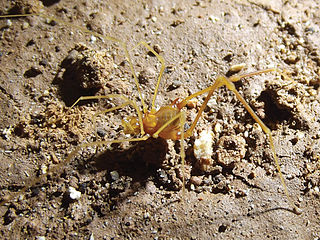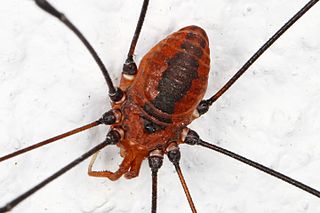Related Research Articles

The Opiliones are an order of arachnids colloquially known as harvestmen, harvesters, harvest spiders, or daddy longlegs. As of April 2017, over 6,650 species of harvestmen have been discovered worldwide, although the total number of extant species may exceed 10,000. The order Opiliones includes five suborders: Cyphophthalmi, Eupnoi, Dyspnoi, Laniatores, and Tetrophthalmi, which were named in 2014.

A scute or scutum is a bony external plate or scale overlaid with horn, as on the shell of a turtle, the skin of crocodilians, and the feet of birds. The term is also used to describe the anterior portion of the mesonotum in insects as well as some arachnids.

A botanical name is a formal scientific name conforming to the International Code of Nomenclature for algae, fungi, and plants (ICN) and, if it concerns a plant cultigen, the additional cultivar or Group epithets must conform to the International Code of Nomenclature for Cultivated Plants (ICNCP). The code of nomenclature covers "all organisms traditionally treated as algae, fungi, or plants, whether fossil or non-fossil, including blue-green algae (Cyanobacteria), chytrids, oomycetes, slime moulds and photosynthetic protists with their taxonomically related non-photosynthetic groups ."

The Eupnoi are a suborder of harvestmen, with more than 200 genera, and about 1,700 described species.
Dyspnoi is a suborder of harvestmen, currently comprising 43 extant genera and 356 extant species, although more species are expected to be described in the future. The eight families are currently grouped into three superfamilies: the Acropsopilionoidea, Ischyropsalidioidea, and Troguloidea.
Banksula melones is a species of harvestman in family Phalangodidae. It is endemic to caves along the Stanislaus River of California, United States.

The Phalangiidae are a family of harvestmen with about 380 known species. The best known is Phalangium opilio. Dicranopalpus ramosus is an invasive species in Europe.

Bishopella is a genus of the harvestman family Phalangodidae, with two described species. B. jonesi occurs only in Alabama, while B. laciniosa is found in the southeastern United States.

Phalangioidea is a superfamily of the harvestman suborder Eupnoi with five recognized families and more than 1,500 species.

Tolus is a genus of harvestman in family Phalangodidae with the sole described species Tolus appalachius. It is only found in Tennessee.
Nemastomoides is an extinct genus of harvestmen known from the Carboniferous fossil record. The genus is the only member of the family Nemastomoididae and contains three described species. Nemastomoides elaveris was found in the Coal Measures of Commentry in northern France, together with Eotrogulus fayoli.
O. spinosa may refer to:
P. silvestrii may refer to:
H. grandis may refer to:
The Cokendolpher cave harvestman, Texella cokendolpheri, is a species of cave-living harvestman native to Bexar County, Texas. The original common name, the Robber Baron Cave harvestman, stemmed from the cave which the harvestman inhabits. The scientific name and the current common name honor the prominent arachnologist, James Cokendolpher, who identified the species. T. cokendolpheri is one of twenty-eight species within the North American harvestman genus Texella. The first formal description of the harvestman took place in 1992 and the species’ listing under the Endangered Species Act followed eight years later. Current threats to the species include habitat loss and interactions with invasive fire ants.
The giant Laotian harvestman is the unofficial name for an as-yet undescribed species of Opiliones belonging to the family Sclerosomatidae. The species was discovered in April 2012 near a cave in the southern province of Khammouan, by Dr. Peter Jäger of the Senckenberg Research Institute in Frankfurt, Germany, whilst shooting a television documentary about the wildlife of Laos.

Iandumoema is a genus of harvestmen, with three species: Iandumoema uai, I. setimapocu, and I. smeagol, each known only from caves in the state of Minas Gerais, Southeastern Brazil. The genus name derives from the Tupi language words iandu ("spider") and moema ("false"), in reference to the popular misconception that harvestmen are spiders. The species Iandumoema smeagol lacks eyes.

Taracidae is a family of harvestmen in the order Opiliones. There are 4 genera and 23 described species in Taracidae.

Leiobunum vittatum, the eastern harvestman, is a species of harvestman in the family Sclerosomatidae. It is found in North America. They are most active from late spring to early fall, with late summer being when eggs are laid. Omnivorous, they feed on plant fluids, fungi and other arthropods. During autumn, they've been known to gather together to stay warm in tree holes or other shelters.

Otilioleptidae is a monotypic harvestmen family, placed within Gonyleptoidea. It contains a single genus, Otilioleptes, and a single species, Otilioleptes marcelae. This harvestman is a troglobite, to date only found in the lava tube known as "Doña Otilia", Payunia region, Mendoza province, Argentina.
References
- Joel Hallan's Biology Catalog: Stygophalangiidae